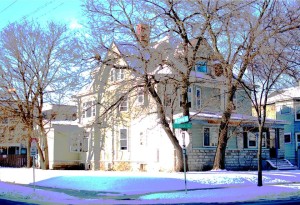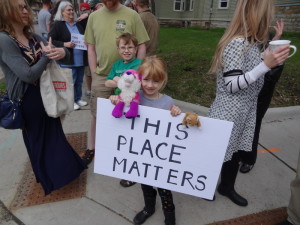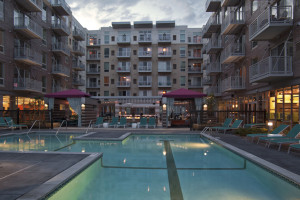
Welcome to the
Healy Project
Join us on Facebook
Send us an Email
Talk: Preservation Advocacy, August 17th
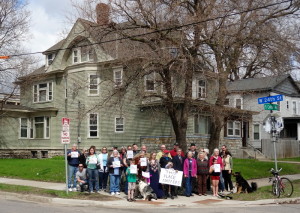
Supporters of the Healy Project gather in front of the Orth House for a photo to be posted on the National Trust’s page, “Places That Matter.”
The story of the fall of the Orth House will be told as part of a talk and exhibit on preservation advocacy sponsored by Preserve Minneapolis and the Preservation Alliance of Minnesota. Anders Christensen of the Healy Project will narrate the two-year- long fight to save the 1893 Healy-built house from demolition. The story of the Orth House, along with other stories of preservation advocacy, will be part of a talk and discussion at the Hennepin History Museum, 2303 Third Ave. South. Thursday, August 17th, 6:30-9:30 p.m. The museum is hosting an exhibit of these stories beginning August 10th.
If you can’t make it to the talk or exhibit, you can read about the fight for the Orth House, its demolition and the aftermath on posts on this blog. It’s a story that’s painful for those of us who fought to save it. . . .and a story that members of the City Council, City Planning, and local developers would like to forget. But it should and must be told.
The deck is almost always stacked against old historic buildings when developers take their promises of higher density and higher tax base to City government. The big triumph over the small, the new over the old, the affluent over those of modest means. The Healy Project will keep fighting as long as old buildings are threatened. And they will always be threatened.
T.B.
These outdated wrecks need to be cleared away to make room for the dense, cosmopolitan city of the future. As Gopher City developer Bill Demhigh likes to quip, “I never saw an old house that didn’t look like a building site to me.” Demhigh, by the way, recently won Gopher City’s Cue Ball Award for the developer who knocks the most buildings down to put his in.
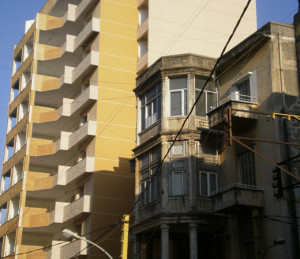 |
| SPACE: There’s no place for monstrosities such as the house at right in the dense, competitive city. Down they go for clean, lean highrises like the one at left. |
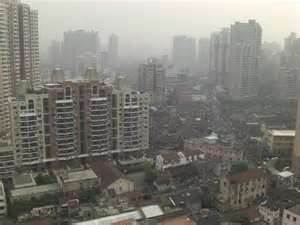 |
| THEORY: With our planning and vision, this is what the new Gopher City will look like in ten years. |
 |
| SPACE: This is an example of a real, competitive global city, Hong Kong. What an inspiration! |
–T.B., with thanks to Sinclair Lewis and Stephen Colbert
One of the boasts of contemporary urban planners is that high density brings to the city a variety of benefits, such as energy savings, public transportation, and a boost to the local economy and city tax coffers. The four-story Lander development that seeks to replace the two houses at 2316-2320 Colfax Avenue is a harbinger of higher density in the apex of the Wedge. This increased density will have a long-term impact on livablility in the neighborhood. While it is true that higher density can mean a more efficient use of resources, it can also bring social ills, such as the displacement of tenants of limited means and families with children, as well as the destruction of community identity.
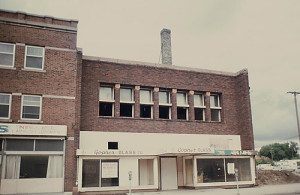 |
| The Hegg Building, Purcell and Elmslie, 1915, demolished for K-Mart, 1980. An example of thoughtless redevelopment. |
I have lived in Lowry Hill East since 1976. The ‘Seventies witnessed an ongoing struggle between Wedge residents trying to make this an attractive place to live and the forces of urban decay–prostitution, drugs, delinquency, and heavy commuter traffic. Most of the new homeowners were attracted to Wedge houses because: 1) real estate was relatively inexpensive, 2) the old houses had architectural charm, and 3) a lively, politically savvy community had taken root in the form of LHENA.
But even though LHENA accomplished much at City Hall (partial downzoning and traffic reduction for two), individuals as well had to step up and do battle. One example was on my block of Emerson Avenue. In the early 1980s, an old couple cashed out their duplex two doors down from my house to a slumlord. The duplex became a drug warehouse, with more than 20 unrelated people inhabiting the lower unit. Taxis and cars pulled up at all hours of the day and night, picking up packages. Drugged out tenants harassed all their neighbors with rude comments and raucous behavior. My next door neighbor at that time was an IRS agent, completely unfazed by having to work his way through multiple levels of government. It took a whole year, but one day Minneapolis SWAT turned up and hauled away the drug warehouse people in the duplex, and the slumlord became the target of an IRS audit.
 |
However, most of the battling was done by homeowners in the northern R-6 part of the Wedge, the higher density area. To protect themselves, their families, and property, homeowners monitored badly managed apartment buildings and rooming houses, calling in the police and City housing inspectors.. But often, City agencies weren’t able to stop the problem, forcing residents to act on their own. In one memorable case, a two-and-a-half story walkup on Bryant Avenue had become home to prostitutes who had frequent noisy nocturnal customers. One of these guys showed up like clockwork on weekends, creating a disturbance in the wee hours of the morning each time. After a number of strategies failed to stop him, one night the owner of the house across the street got in his car and followed the John to his home in Golden Valley. There the homeowner confronted him with the news that if he, the John, ever made a disturbance in the Wedge again, the homeowner would be coming out to tell his wife and children of his activities. The John was never seen again.
Through these and similar heroic efforts, the homeowners of the Wedge, along with their allies among renters and landlords, have made Lowry Hill East one of Minneapolis’s most desirable places to live and work. In so doing, they have made considerable investments of time and capital. However, with the proposed displacement of two houses by a new apartment complex, it seems that the neighborhood is becoming a victim of its own success. Lander has redeveloped the southern Greenway part of the Wedge into many apartment, townhouse, and condominium units. Now Lander, along with the City, is planning to start the redevelopment of the apex into another high density area. Have these homeowners fought this long battle to save the neighborhood and its houses, only to be exploited and ultimately driven out by the City?
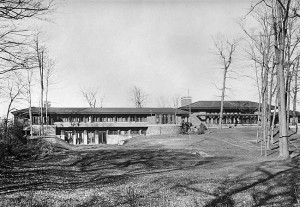 |
| The Francis W. Little House in Deephaven by Frank Lloyd Wright, 1912-1972. Demolition, like extinction, is forever. |
Sometimes it’s enlightening to see one’s neighborhood through the eyes of outside observers. On one dark November evening last year, I took a shuttle from the airport to my house. I was the only local resident aboard the shuttle; the other eight passengers were business people headed for downtown hotels. Despite my request to stop, the driver overshot my house by about a half block. As I tried to exit the van, the other passengers insisted that the driver back up to let me off directly in front of my house. Why? To them, the place looked very scary, and they were sure I’d be in danger out on the street. As I clambered from the back seat to the door, I tried to assure them that I would not be mugged on my way to the corner. But it was no use. People see things through the filters of their preconceived notions and experience. To them, this was the old inner city, alien and terrifying. I’m sure some of them would have been all for razing the entire neighborhood and building shiny new glass, brick and metal condos and apartments in its place.
This kind of skewered view of the neighborhood is one of the reasons that I am not impressed by the arguments for higher density by those who live in low-density neighborhoods of the city. As one who has lived in the Wedge for 36 years, I’ve seen the attempts to remove “urban blight” first through the building of small walkup apartment buildings, and now, through the construction of apartments and condos for the affluent.
The Wedge already has its fair share of high density housing in the Lander Greenway developments and the apartment buildings on and near Hennepin and Lyndale Avenues. Those who want higher density in the apex would be more convincing if they themselves lived in high density areas. Put your money–and home purchases–where your mouth is. Only those who have homes in high density areas can understand the day-to-day trials and challenges: the traffic snarls, snow emergency melees, street noise, loud parties, drunken revelers, etc. As density increases, such areas become less attractive to families, who understandably prefer to raise their children in neighborhoods of single-family homes.
As an election judge in 10-2, I got to see hundreds of my neighbors–people who stood in the cold and rain for an hour or more to exercise their right to vote. Young and old, gay and straight, professional and blue collar, handicapped and able, affluent and poor, married and single, native-born and naturalized, of all colors and races–they represent what makes the Wedge a great place to live.
I say again, if 2316 and 2320 are wrecked for the four-story Lander apartment building, it will be the harbinger of more of the same. Density doesn’t always mean diversity. Keep tearing down houses for condos and apartment buildings and inevitably some groups will start disappearing from the mix–families, old folks, people of modest means.
If the Lander project goes forward, it will send a clear signal to those who hope to redevelop Lowry Hill East into a high density Eden: Gentlemen, start your bulldozers.
Next: Theory and Practice in Urban Planning.
–T.B.
